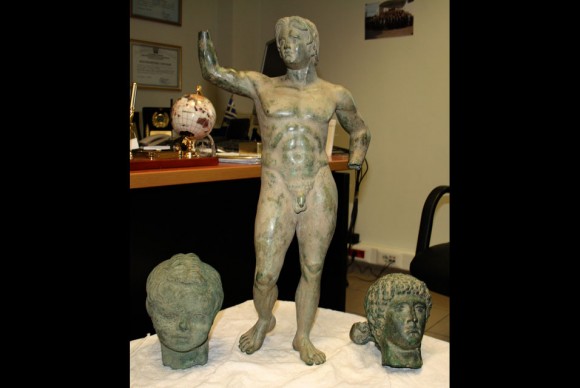Greek Police Arrest Two Men with Valuable Antiquities
THESSALONIKI.- Greek police arrested two men trying to sell several artifacts, including a bronze sculpture of emperor Alexander the Great from the 4th century B.C., for which the asking price was euro7 million ($9.5 million), authorities said Sunday.
Police identified the suspects as a 48-year-old Thessaloniki businessman and a 51-year-old farmer, but did not provide their names.

This image made available on Sunday, Feb. 28, 2010 by Greek police shows in the northern Greek port city of Thessaloniki a bronze statue of emperor Alexander the Great flanked by two bronze heads from the Roman period. Police arrested two individuals trying to sell these and other antiquities on Saturday. The asking price for the Alexander statue alone was 7 million euros. Experts say the statue is likely from the workshop of Lysippos, a 4th century BC Greek sculptor who was Alexander's contemporary and personal sculptor
The men were arrested Saturday morning near the town of Kavala, east of Thessaloniki, police said. Police searched their car and found a treasure trove that included a 65-centimeter (2-foot) statue of Alexander, two bronze heads of a boy and a young man and other artifacts, including two rare Qurans.
“According to our information, the (suspects) have been trying to sell the sculptures for about a year,” senior Thessaloniki police official Dimitris Tsaknakis told The Associated Press. “They have been asking euro7 million for the Alexander sculpture and between euro4-6 million ($5.43 million-$8.14 million) for the boy’s bronze head.”
Experts say the Alexander statue appeared to come from the workshop of Lysippos, Alexander’s personal sculptor. Chemical tests are being conducted at the Thessaloniki Archaeological Museum to see whether the sculpture is an original or a contemporary copy, since Lysippos’ workshop, which employed several artists, also produced replicas of original works.
The young boy’s bronze head, apparently part of a larger sculpture, is dated from the Roman era, in the 1st century B.C.
Police officials say it is likely the two smuggled the antiquities and the Qurans from Turkey, but at this point they are not certain about their place of origin.
Related posts:
- Biggest Work by Bouzanis to Appear at Auction at Bonhams Greek Sale
- Feds arrest Granite Falls couple in stolen art ring
- Stolen Painting Believed to Be a Modigliani Held Clue to Serbia War Crimes Arrest
- Sotheby’s Greek Sale to Include Important Examples of Greek Modernism by Masters
- Police on the Hunt for Picasso Drawing Stolen from San Francisco’s Weinstein Gallery
